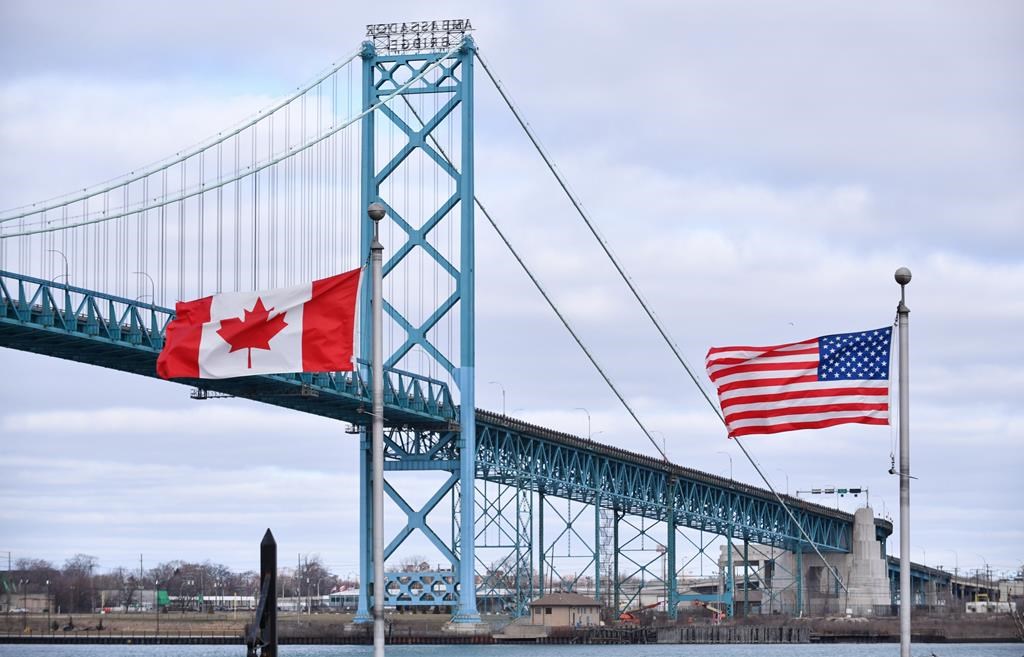There are currently no public health officials stationed at Canada-U.S. land border crossings to assist in screening for COVID-19, Global News has learned.

The union that represents border officers has been asking the government to place health officials at all major land border crossings for weeks, but so far nothing has been done, said union president Jean-Pierre Fortin.
“Zero. Zero presence,” Fortin said.
In March, Canada closed its border to foreign nationals who had recently travelled outside Canada or the United States.
Border restrictions were then extended to include all non-essential travel between Canada and the U.S., and a mandatory, 14-day self-isolation period is now required for anyone returning.
To facilitate these measures and assist border officers in the screening process, the Public Health Agency of Canada (PHAC) stationed health officials at airports and began handing out pamphlets with information on social distancing, quarantine and other health precautions people must follow.

According to the Canada Border Services Agency (CBSA), its enhanced screening measures at airports include directing anyone who says they feel ill or who displays signs of sickness to on-site PHAC employees for further questioning.

Get daily National news
But this isn’t happening at land border crossings because no PHAC employees are stationed there.
And with the majority of people entering Canada travelling by land — including thousands of essential workers who cross the border daily — Fortin says the health and safety of border officers are being put at risk due to the absence of immediate and sound medical advice.
“We’re still prepared to do the work and keep Canadians safe, but a little help from Health Canada would be really appreciated,” Fortin said.
Land crossings exceed air travel
According to data released by the CBSA, roughly 478,000 people entered Canada in the first two weeks after border restrictions were implemented. About 65 per cent of these travellers entered Canada through a land border crossing.
Between March 30 and April 5, the most recent week for which data is available, land border crossings outpaced air travellers by a factor of almost four to one.

Fortin says the biggest advantages of having public health officials at land border crossings would be for them to see the daily working environment for CBSA officers and provide on-the-spot guidance with the screening process.
He also said he can’t understand why PHAC staff would be placed at airports and not land border crossings, especially when these sites are now the biggest contributors to cross-border travel and places like Detroit, Mich. — just across the river from Windsor, Ont. — have become epicentres for the global COVID-19 outbreak.
“If one of our officers gets contaminated and can spread the disease, we’re not going to be ahead here,” he said.
Public health officials available ‘by phone’
Global News asked Public Safety and Emergency Preparedness Minister Bill Blair — who’s run point on all border-related issues during the pandemic — to explain why PHAC employees are not stationed at Canada’s land border crossings. A spokesperson for Blair’s office directed the request to Health Canada, saying it would be better positioned to provide a response.
Health Canada, which is responsible for PHAC, said it has several “standard border measures in place” to mitigate the risk of introducing and spreading communicable diseases in Canada, including 24-7 access to a PHAC quarantine officer from all international points of entry.
If a border officer believes someone is sick or has symptoms that could pose a threat, they will contact a quarantine officer who can make an assessment and may order the traveller to undergo a medical examination, said Health Canada spokesperson Natalie Mohamed.
Health Canada did not, however, explain why there are no PHAC employees stationed at land border crossings, nor did it explain the process by which CBSA officers at the Canada-U.S. border contact public health officials if they believe someone poses a risk.
The CBSA, meanwhile, confirmed that no public health officials have been placed at land border crossings and said initial contact between the CBSA and PHAC is done over the phone.
“We are continually assessing our operational posture with our colleagues at the Public Health Agency of Canada, including where their screening officers and quarantine officers are needed and best utilized. Should circumstances change, we will revisit,” said CBSA spokesperson Rebecca Purdy in a written statement.
The CBSA also said the health and safety of its officers is its top priority and that all front-line workers are provided with personal protective equipment and specialized training at both airports and land border crossings.
Anyone entering Canada who says they are sick or who displays signs of illness is provided with information on how to self-isolate and quarantine requirements.









Comments